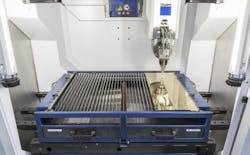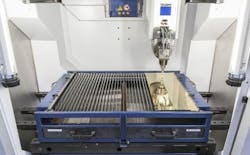Cirrus Laser makes gain with 5-axis laser cutting and welding system
Burgess Hill, West Sussex, England - In July 2014, Cirrus Laser Ltd. installed the UK's first Trumpf TruLaser Cell 3000 five-axis laser welding and cutting system—and it is already offering important market advantages to this progressive subcontract supplier of sheet metal and plate processing services.
Capable of both laser cutting and welding on the same platform, the TruLaser Cell 3000 is run alongside the company’s existing TruLaser 5030 fiber flatbed laser. In fact, the same 3kW laser source is used to supply both machines and switching between the two could not be easier. There is no configuration or unplugging of leads—everything is software-driven and can be activated at the push of a button.
“At present, finding new flatbed laser work in the market is quite tough, hence the move into five-axis cutting and welding,” explains David Connaway, Cirrus Laser's managing director. “Ultimately, the plan is to run the 5030 fiber during the day, and the Cell 3000 overnight. This will help us move towards 24-hour operations, 52 weeks of the year, whereas currently we only run 24 hours for around 30 weeks.”
“The first job we welded was aluminum, which was a real success, and that job is coming around again in the next few weeks,” says Connaway. “We have also welded steel and cut logos and text into aluminum buttons for an aerospace customer. We are now planning to fit a tailstock within the next few weeks that will enable us to complete rotary work.”
Forthcoming jobs planned for the TruLaser Cell 3000 include welding of diamond core drills used for producing holes in concrete. Cirrus Laser has produced a quarter-million of these drills in the past and the acquisition of the TruLaser Cell 3000 will introduce new efficiencies to the process.
Another benefit for Cirrus Laser concerns parts that are presently TIG-welded off-site and subsequently require cleaning up before painting. Establishing a laser welding resource in-house not only saves on subcontract costs, but produces welded assemblies that can go straight to painting with minimal or no clean-up.
“There’s no doubt that the machine will be a strong business asset as we move forwards,” concludes Connaway. “We are still finding our way with the transition from 2D to 3D programming and are learning more every day."

